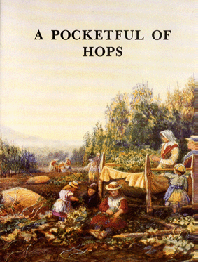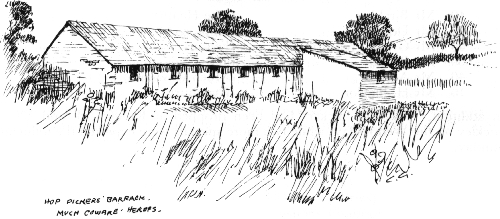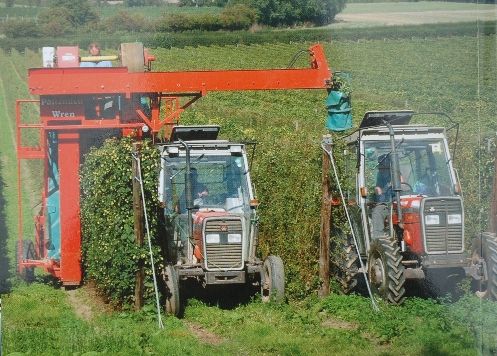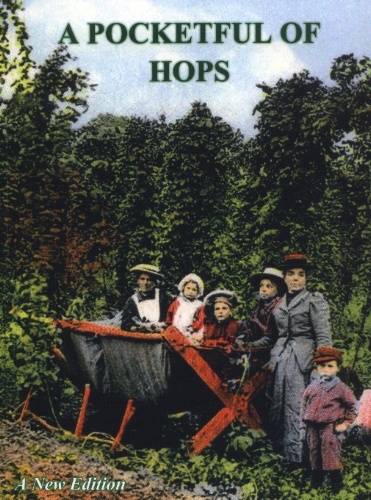 Hop Growing in the Bromyard Area – A New Edition (2007)
Hop Growing in the Bromyard Area – A New Edition (2007)
The original edition was published in 1988 and has sold all over the world. The text has been revised and additional material describes modem practices and equipment; a new chapter tells the story of dwarf or hedge hops. Maps, graphs and tables have been brought up-to-date. New photographs have been added.
This book is essential reading for those interested in hop growing, and for those curious to learn how the cultivation and marketing of hops fitted in to the local economy of north-east Herefordshire. It is of approximately 200 pages and is profusely illustrated.
The first edition was one of the most successful books published by our society. It has sold throughout the country and around the world. The book has now been reprinted, and improved, by popular demand.
Below: Cover illustration of original edition, 1988
Chapter Contents of new book – with opening paragraphs
1 The Flavour in the Beer
It is hard to imagine the disruption of normal commercial and social life that only a generation ago would descend on Bromyard and the surrounding countryside for a month each year. September meant one thing – hop picking.
2 A View from the Farmhouse
During hop picking the usual pattern of life was disturbed for the whole area. Bromyard became a ghost town with nothing stirring – except on a Saturday afternoon. No public functions were held and nothing could be done until ‘after hop picking’. Hop farmers and their families remained at home except for essential business and shopping, and meals were fitted in to suit bushelling and kiln changes.
The majority of the pickers were women and children, in most cases setting out to earn a much welcomed supplement to the family income; a winter coat, a shedful of coal, new furniture or the school uniform for a scholarship child. How the mothers enjoyed this money, particularly because it was theirs to spend as they wished on their own special security or luxury. For three or four weeks all household chores laid aside, they set out with their macs and stools, sandwich boxes and old kitchen knives to take up residence in the hopyard houses, in a different community bound by strict rules enforced by the pole-pullers and a timetable dictated by the busheller in the drying kilns.
3 ‘They was Lovely Days’
As the year begins to turn into Autumn and there is a certain misty freshness in the morning air with the promise of warmth later on, local people still say, ‘It’s a real hop-picking morning.’ They seem to sniff the air and nod in agreement that whatever they are about to do they would much rather be setting off to the hopyard for a day’s hop picking, as they would have done thirty or forty years ago.
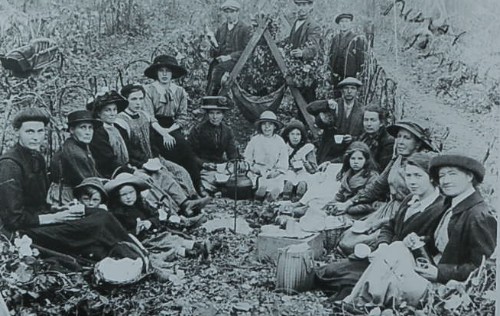
This hopyard in Acton Beauchamp may have been using the Butcher system of wire-work invented in Kent in 1875. The kettle hangs over the fire ready to replenish the teapot, however Nurse Powell has bought her own thermos flask!
4 ‘Clear ‘Em Up’
In the researches for this book, letters were written to some of the Birmingham and Black Country newspapers asking people to write their memories of hop picking before the days of the machine. We were surprised to get such a large response to our enquiries and find what happy memories the old hop-picking days evoked. Of course, these letters are from older people who came hop picking as children and perhaps remember the old days with childhood affection; to their mothers hops meant hard work in good weather and bad, and a few shillings towards the family needs.
We have had to pick extracts from these letters but have tried to keep their flavour, so evocative of a past era. The editor of The Birmingham Post & Mail. Keith Whetstone, was the first to reply with his experiences at Nashend Farm during the Second World War.
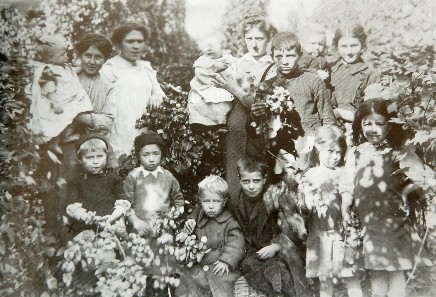 Pickers from Birmingham in the hopyards of Whitbourne in the 1920’s
Pickers from Birmingham in the hopyards of Whitbourne in the 1920’s
5 Hymns, Health and Holidays
The many thousands of hop pickers who came into the countryside required a great deal of care and organisation, involving the local Churches, medical services, police and education authorities. But first the pickers had to be brought to the district and this was the responsibility of the railways and later, road transport. The Bromyard News and Record of 31 August 1905 has details of the arrival at Bromyard that week of the hop pickers’ special trains, and lists the number of pickers, not counting the numerous children, destined for various farms in the district:
6 A Farmer’s Diary
The late Ted Holloway of Lower House, the Bull Ring and Hope House in Stanford Bishop, and Sevington in Acton Beauchamp, kept a series of day books covering the years 1951 to 1977.
Not all the events occurred in any one year, but an attempt has been made to show the working year on a mixed farm, where hops were only one of many enterprises, by condensing the twenty-seven year span of entries into twelve months.
7 Students and Shepherd’s Pie
The establishment of the picking machine in the mid 1960s caused infinite regret to many people, but surely sighs of relief were heaved by farmers’ wives and families. Life must be easier for them than during hand-picking days now that more depends on a well-regulated machine and less on unpredictable hungry human beings. However, for the high quality crops wanted by the brewers today, hops have to be harvested at the peak of their condition. This means working for the maximum number of hours during that time, and Gwenllian Paske of Upper Lyde, writing in I 988. begins her account of how hop-picking affected the farm-house with sentiments remarkably familiar.
8 Hop Kilns
Hops must be carefully dried and special buildings have been developed for this purpose in Herefordshire these are known as hop kilns, but in other areas they are termed oasthouses. An early method of drying was to spread the green hops on an upper floor or in an attic and allow them to dry naturally. In his book ‘A Perfite Platforme of a Hoppe Garden’ published in 1574, Reynolde Scot describes such a method: “If you have no Oast dry them in a loft open to the air as maybe lay them not above half a foot thick and turn them once a day at the least, by the space of two or three weeks sweep them up into a corner let them lay for as long more.” Some local growers without kilns were using Scot’s method as late as the 19th century, whilst others took their hops to be dried by neighbours; eventually most hop growers built their own kilns. In 1842, for example, there were 23 farms in Stoke Lacy growing hops, of which at least 14 are known to have had kilns or to have built them later.
9 The Hop Grower’s Year
Since the Second World War the methods and productivity of British agriculture have probably altered and improved more than during any equivalent time span, and in the following calendars Harry Paske explains the differences that have occurred in hop growing. The system described before 1950 is as he remembers it at Little Froome. Hop growing was given up there in 1964 so he has described his own system at Upper Lyde for the 1980s.
The methods are peculiar to the periods and to the individual farms. No two hop growers ever had the same ideas or did things in the same way, and no two hop growers ever will, but the changes depicted are generally representative of the whole industry.
10 Servicing the Hop Industry
About 800 United Kingdom farmers grew hops in the ‘50s, but by 2005 the number was down to less than 121 in England, so implement makers for the hop industry have not had the benefit of large scale production as have other sectors of farming. In the early days of the tractor, however, general farm cultivating implements, having been designed for horses, were small enough to travel hop rows anyway and only slight alterations to the hitching arrangements were necessary. Ransomes of Ipswich used to make special hop ploughs and heavy disc cultivators, and Craven of Evesham were among the first makers of dusting and spraying equipment in the days of the horse. The main local suppliers of specific hop equipment used to be Wargent Brothers of Stoke Edith (later with Morris, Wargent and Wilde at Whitestone), Ted Wargent of Canon Frome, John Hill of Ledbury and Pettifer of Bromyard. They provided everything the growers needed from complete hop kilns to the steel ground pegs required by each root for the application of the coir yarn for the hops to climb. Cutting 18 inch lengths of ¼-inch steel rod and forming the hooks was a steady, time consuming job for when business was slack. Each acre required about 1800 pegs.
11 Twentieth Century Developments in Hop Growing
Few industries have changed more than hop growing in the last seventy years. The fundamental part, the hop has changed; cultivation, pest, disease and weed control, picking, drying and marketing have altered, and the growers and their labour have had to develop entirely different skills.
12 Hop-Picking Machines and Drying
Apart from in America where machines have catered for much bigger farming operations, Bromyard was the original centre of the development of hop-picking machinery throughout the world. In 1934 McConnel Hinds of Martley built a prototype flying finger’ hop-picking machine. Norman Edwards of Rosemaund (where the Experimental Husbandry Farm is now), having watched the developments, installed a machine for the 1937 harvest. Ernest Griffiths of the Stocks, Suckley, James Bomford of Spring Hill near Pershore, Tom Hawkins at Thinghill Court and Fred Coleman in Kent were also using this early machine. After the war, in 1949, Percy Parker at Newton Farm, Stoke Lacy, also had a McConnel Hinds flying finger machine, although by then it was installed by Rubery Owen of Darlaston. This model, however, never subsequently became popular. George Hinds and McCoimel later split up and George Hinds continued with hop-picking machines from Barnard’s Green, Malvern. He also designed a Rotobank mobile harvester which could be driven from the PTO (power take oft) of a tractor or Landrover and which he exhibited in Germany. Several attempts have been made by different makers to manufacture mobile picking machines but very few have been sold, perhaps because they tend to be too cumbersome for convenient movement in the restrictive wirework of hopyards, and in wet seasons there would be the fear of being bogged down and causing considerable structural damage to the soil.
13 The Dwarf Hop Story
The labour demands of harvesting hops on tall wirework systems are all to familiar to many of us. Each and every plant has to be cut down and hauled to a static picking machine, so growing hops as a ‘combinable crop’ has obvious advantages. But the complexities encountered in developing this have been neither obvious nor simple to resolve.
A Pattenden Wren Dwarf Hop Picking Machine at work
14 Marketing Yesterday and Today
One of the many problems for hop growers is that it has only one significant buyer – the Brewer. To try to reduce this dependence, other uses have been explored from time to time.

